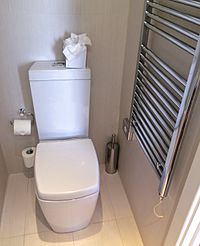
Back مرحاض مزود بنظام شطف Arabic Splachovací záchod Czech Унитаз CV Toilettenspülung German Akvopelilo (necesejo) Esperanto Vesiklosett Estonian سیفون توالت Persian WC Finnish Rinçage des toilettes French מכל הדחה HE
A flush toilet (also known as a flushing toilet, water closet (WC); see also toilet names) is a toilet that disposes of human waste (principally urine and feces) by using the force of water to flush it through a drainpipe to another location for treatment, either nearby or at a communal facility, thus maintaining a separation between humans and their waste. Flush toilets can be designed for sitting or squatting, in the case of squat toilets. Most modern sewage treatment systems are also designed to process specially designed toilet paper. The opposite of a flush toilet is a dry toilet, which uses no water for flushing.
Flush toilets are a type of plumbing fixture and usually incorporate an S-, U-, J-, or P-shaped bend called a trap that causes water to collect in the toilet bowl to hold the waste and act as a seal against noxious sewer gases. Most flush toilets are connected to a sewerage system that conveys wastewater to a sewage treatment plant; alternatively, a septic tank or composting system may be used.[3]
Associated devices are urinals, which primarily dispose of urine, and bidets, which use water to cleanse the anus, perineum, and genitals after using the toilet.
- ^ Environmental History of Water[permanent dead link], p. 40
- ^ von Münch, E.; Milosevic, D. (2015): Qualitative survey on squatting toilets and anal cleansing with water with a special emphasis on Muslim and Buddhist countries by using the SuSanA discussion forum. Ostella Consulting, Schwalbach, Germany
- ^ Kagan, Mya. "Where Does the Water Go When I Flush the Toilet?" Kids' Why Questions. Whyzz. Publications LLC, 2011.
© MMXXIII Rich X Search. We shall prevail. All rights reserved. Rich X Search

